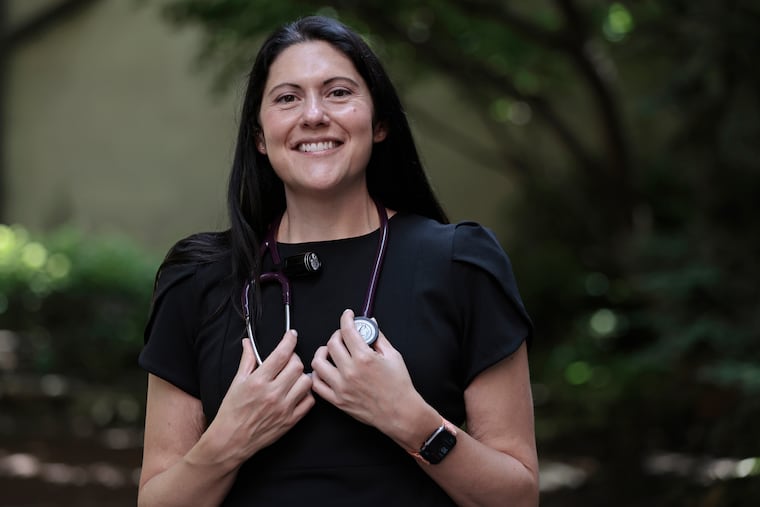This Philly doctor credits her Apple Watch with saving her life during heart emergency.
One Philly doctor credits her Apple Watch with alerting her to a dangerously high heart rate.

Erica Harris’ first clue that something was wrong came from her Apple Watch.
Stuck in traffic one cold November afternoon in 2021, Harris felt it vibrate, fast and nonstop. Then she got an alert that her heart was beating too fast and irregularly, a potentially dangerous condition called rapid atrial fibrillation (AFib.)
Harris was lucky to know what to do. An emergency medicine physician at Jefferson Einstein Philadelphia Hospital in North Philadelphia, she used her own hands to push down on her chest, increasing the pressure on her heart, which was enough to put it back into a normal rhythm.
Without the watch, she says she might not have known anything was wrong. She didn’t feel any chest pains or palpitations, and had never experienced rapid AFib before.
“It had been going on almost five minutes, which is the point where you’re at risk of developing stroke,” said Harris, 43, who was born with a congenital heart defect that has required two surgeries.
After the Apple Watch alert, she met with her cardiologist who prescribed her blood thinning medication to use if she ever experienced Afib again.
Harris is among the 20% to 30% of American adults who own a wearable health device such as an Apple Watch, Fitbit, or Garmin, often every day, according to Care Evolution, a health-care software research company based in Ann Arbor, Mich.
The devices don’t just measure your steps or how many calories you burn running or playing pickleball. For certain health measures, wearers are also able to self-monitor in real time, most notably related to heart health.
That information can be helpful, but has its shortcomings. The data may not always be accurate and comes without professional guidance.
The American Heart Association recommends that if you receive an alert from your device, you should seek medical advice and get an electrocardiogram to confirm the rhythm.
Harris’s cardiologist at Jefferson Health, Joshua Copeland, doesn’t recommend that all of his patients get them.
“I’ve had patients come to me with alerts from their wearable devices that weren’t verified by more sophisticated tools,” said Copeland, attending physician in Jefferson’s division of cardiology.
Monitoring heart activity
An Apple Watch, for example, can notify wearers if it detects a high heart rate when a user is at rest, which can be a sign of a serious underlying condition, or when their heart rate is notably low for at least 10 minutes, known as bradycardia.
The device also occasionally looks at your heartbeat to check for an irregular rhythm that might suggest AFib, as in Harris’s situation.
An additional feature lets users take measurements similar to a single lead electrocardiogram (EKG or ECG,) a test to record the electrical signals in the heart. That information can be immediately shared with a doctor for further advice.
But research shows mixed results on how accurate and reliable the devices are.
In November 2022, a team of physicians, members of the AF Screen International Collaboration, reviewed the available literature to assess the accuracy of these tools.
The information from the device is not always accurate, said Stavros Stavrakis, cardiologist at the Heart Rhythm Institute of the University of Oklahoma Health Sciences Center and a member of the American Heart Association. What’s more, every person is different so without the benefit of a doctor’s advice, the device wearer can’t know how serious the alert may be.
“We need to be sure we have an accurate diagnosis,” he said.
They found that the heart-related information was about 90% accurate when the patient was resting. But when the wearer was exercising, the accuracy declined to about 70% because it was picking up that movement, he said.
Limitations and usefulness
Fewer than 1% of Americans who use wearable health devices receive an urgent health alert like Harris received, according to the research review.
Among those older than 65, about 3% to 5% of those wearing a device will get an irregular rhythm alert, Stavrakis said, citing the research.
The most common alert is a warning for AFib, which increases the risk for stroke five times.
Even then, the devices are not always accurate, the research review showed, estimating that about 20% of the alerts are false.
In June, Nora Bursztein was among the small population whose devices alerted them to urgent heart health problems.
The 74-year-old Westampton woman got an alarm on her Apple Watch that her heart rate was 48 beats per minute. It’s typically in the high 60s or low 70s.
“I ignored it, thinking maybe it was the watch,” Bursztein recalled.
It happened a couple more times over the next couple of days, but she continued to blame it on a watch malfunction. When her daughter came to visit, Bursztein put on her daughter’s Apple Watch, which gave the same result. Her heart rate was now under 40, which may cause symptoms like fainting.
“The following day I had surgery,” she said.
The doctor inserted a defibrillator, a device that applies an electric current to the heart to restore a normal heartbeat, and a pacemaker to control her irregular heart rhythm.